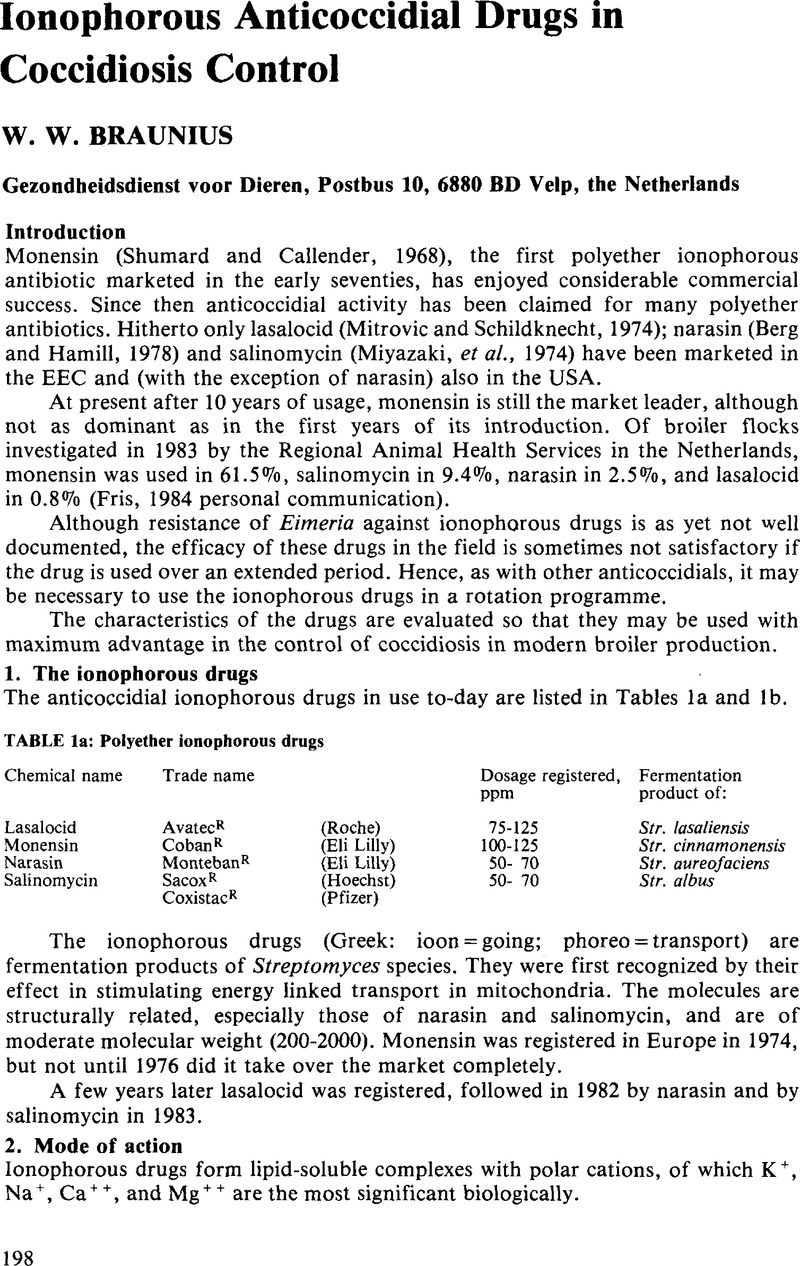Crossref Citations
This article has been cited by the following publications. This list is generated based on data provided by Crossref.
Long, P.L.
and
Jeffers, T.K.
1986.
Control of chicken coccidiosis.
Parasitology Today,
Vol. 2,
Issue. 9,
p.
236.
DOSORETZ, CARLOS
SCHLEIDER, ITZHAK
and
LAMED, RAPHAEL
1987.
Chicken Manure Methanogenesis..
Poultry Science,
Vol. 66,
Issue. 4,
p.
613.
Horovitz, C.T.
Avidar, Y.
Bogin, E.
Shlosberg, A.
Shkap, I.
Weisman, Y.
and
Egyed, M.N.
1988.
Enzyme Profile in Blood and Tissues of Chickens Fed Various Levels of Monensin.
Journal of Veterinary Medicine Series A,
Vol. 35,
Issue. 1-10,
p.
473.
Raether, W.
1988.
Parasitology in Focus.
p.
739.
Mehlhorn, H.
Dubremetz, J. F.
Peters, W.
Franz, M.
Taraschewski, H.
Voigt, W. P.
Walldorf, V.
and
Gustafsson, M. K. S.
1988.
Parasitology in Focus.
p.
161.
Salisch, H.
1989.
Recent developments in the chemotherapy of parasitic infections of poultry.
World's Poultry Science Journal,
Vol. 45,
Issue. 2,
p.
115.
MAES, L.
VANPARIJS, O.
and
MARSBOOM, R.
1991.
Effect of Diclazuril (Clinacox®) on the Development of Protective Immunity Against Eimeria tenella: Laboratory Trial in Broiler Chickens.
Poultry Science,
Vol. 70,
Issue. 3,
p.
504.
Shirley, M.W.
1992.
Research on avian coccidia: An update.
British Veterinary Journal,
Vol. 148,
Issue. 6,
p.
479.
Dowling, Laurie
1992.
Ionophore toxicity in chickens: A review of pathology and diagnosis.
Avian Pathology,
Vol. 21,
Issue. 3,
p.
355.
Wang, Jian
and
Sporns, Peter
2000.
MALDI-TOF MS Quantification of Coccidiostats in Poultry Feeds.
Journal of Agricultural and Food Chemistry,
Vol. 48,
Issue. 7,
p.
2807.
Peippo, Pekka
Hagren, Virve
Lövgren, Timo
and
Tuomola, Mika
2004.
Rapid Time-Resolved Fluoroimmunoassay for the Screening of Narasin and Salinomycin Residues in Poultry and Eggs.
Journal of Agricultural and Food Chemistry,
Vol. 52,
Issue. 7,
p.
1824.
Karimi, Ahmad
2008.
Effect of Narasin and Dietary Protein Source on Performance of Broiler.
Journal of Biological Sciences,
Vol. 8,
Issue. 6,
p.
1077.
Chapman, H.D.
Jeffers, T.K.
and
Williams, R.B.
2010.
Forty years of monensin for the control of coccidiosis in poultry.
Poultry Science,
Vol. 89,
Issue. 9,
p.
1788.
Chasser, K.M.
Duff, A.F.
Wilson, K.M.
Briggs, W.N.
Latorre, J.D.
Barta, J.R.
and
Bielke, L.R.
2020.
Research Note: Evaluating fecal shedding of oocysts in relation to body weight gain and lesion scores during Eimeria infection.
Poultry Science,
Vol. 99,
Issue. 2,
p.
886.
Yadav, S.
Teng, P.-Y.
Singh, A.K.
Choi, J.
and
Kim, W.K.
2022.
Influence of Brassica spp. rapeseed and canola meal, and supplementation of bioactive compound (AITC) on growth performance, intestinal-permeability, oocyst shedding, lesion score, histomorphology, and gene expression of broilers challenged with E. maxima.
Poultry Science,
Vol. 101,
Issue. 2,
p.
101583.



